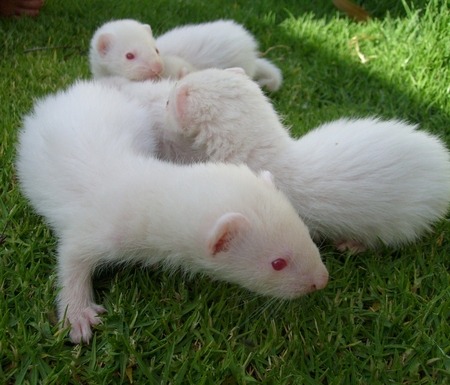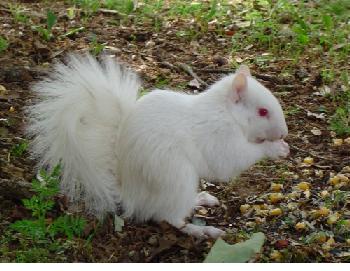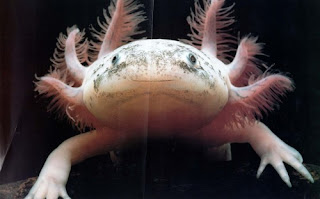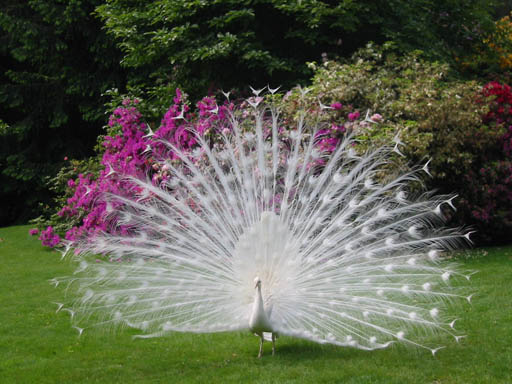|
|
|---|
Sunday, March 20, 2011
To tell you the honest truth, I had never even heard of axolotls until one of my most faithful fans asked me to write a blog entry about them. So I looked them up, and I found out that they are these funny-looking Mexican salamanders that only live in one lake in the middle of Mexico. And since that lake is mostly all dried up except for a few polluted canals, the axolotl is CRITICALLY ENDANGERED in the wild.
But what I also learned is that axolotls are easy to breed in captivity, and they are used a lot in research. Also they are kept as pets in the U.S., Great Britain, Australia, Japan, and some other countries. Sometimes they are called wooper loopers, which I think is a cute name, and it's easier to say than axolotl.
There are several things about axolotls that make them different from most salamanders. First of all, they don't go through all the parts of a normal life cycle that an amphibian is supposed to. A frog is an example of an amphibian, and frogs start their lives in the water as tadpoles. And then later they grow legs and lose their tails, and they crawl out on the land and become frogs. Also they breathe through gills when they live in the water, and they use lungs after they get to be frogs. And going through all these changes is called metamorphosis.
Salamanders usually have this same sort of life cycle like frogs do, but axolotls are different. And the way they are different is that they never leave the water when they grow up. They just stay there and keep breathing through gills. We don't know why they don't leave the water. Maybe they just like it better than living on land. Or maybe they were safer living in the water, so they just never evolved to live on the land. Scientists think that axolotls don't have the right thyroid hormones to make them go through metamorphosis and live on land. But anyway, when an animal stays in a juvenile period of its life like this, it's called neoteny.
So that's one thing that is unusual about axolotls. And another thing is that they can heal themselves in amazing ways. Like for instance, if an axolotl loses its leg or its tail, it can grow a brand new one that's just as good as the one that was lost. Also if you do something like transplant an eye from one axolotl into another one, it will grow there and be a nice, usable eye. Researchers are really interested in all this stuff because it helps them understand how embryos develop and how transplants can be done and that kind of thing.
Axolotls are about 9 inches long when they are full grown. Their gills are on stalk-like things on the outside of their bodies, and they look kind of like lacy collars. Also axolotls have fins all the way down their backs. They have wide heads and skinny little legs and toes. The way they eat is they lunge at their food and suck it in. Then they swallow the food whole because they just have little nubby tooth things that never grow into anything they can really bite with.
What axolotls like to eat in the wild is stuff like worms, insects, and small fish. In captivity, they eat earthworms, bloodworms, waxworms, blackworms, whiteworms, brindal worms, daphnia, mealworms, and brine shrimp.
There are four main colors for axolotls. The two colors that you would normally see are wildtype, which is some shade of brown with spots, and melanoid, which is a fancy word for black. Besides that, there are two mutant colors, and they are leucistic (pale pink with black eyes) and albino (golden, tan, or pale pink with pink eyes).

The name axolotl comes from the Aztec language, and it means something like "water dog." Of course, these little salamanders don't look anything like dogs, at least in my opinion. But there used to be this Aztec god named Xolotl, and he would change himself into a water animal to avoid being sacrificed. So that is supposedly where the name axolotl comes from. I'm not sure why the Aztecs would be trying to sacrifice one of their own gods, but this part wasn't explained in what I learned about axolotls.
Anyway, back in the old days, when the Aztecs lived in Mexico, in the middle of a bunch of lakes such as Xochimilco and Chalco and Texcoco, there were tons of axolotls living in the water of the lakes. This was exactly the kind of environment that axolotls liked to live in because it was fresh water at a high altitude. And the Aztecs ate axolotls as part of their diet.
But then Mexico City got built where the Aztecs used to live, and all the lakes got drained and filled in to make land to put the city on. So all that's left is a few canals of Xochimilco, which is a big tourist place where you can go and take a ride on a boat that is all decorated with flowers. Mom was there and rode on the boats back in 1972, when she was much, much younger. She told me that the water looked very dirty even back then, so now it must be lots worse, and it is pretty surprising if any axolotls can stay alive there.
Also besides the pollution, there is the problem of African tilapia and Asian carp being put in the water there, and they are eating the baby axolotls and the axolotls' food. One scientist who has studied the situation made an estimate that there are only about 100 axolotls in every square kilometer of wetlands now, even though estimates were 10 times higher in 2004, and 6 times higher than that in the 1980s. So this is why they say that the axolotl is so critically endangered.
But like I told you before, lots of people have these little salamanders as pets because they are pretty easy to keep if you have an aquarium and the right kind of water at the right temperature and some worms to feed them. You can go online and read all about how to take care of your axolotl, and there are discussion groups, plus you can even buy axolotl plush toys and t-shirts. Personally, I think a dog or a cat would make a better pet because they are cuddlier and smarter, but I guess some people have different ideas about pets!
But what I also learned is that axolotls are easy to breed in captivity, and they are used a lot in research. Also they are kept as pets in the U.S., Great Britain, Australia, Japan, and some other countries. Sometimes they are called wooper loopers, which I think is a cute name, and it's easier to say than axolotl.
There are several things about axolotls that make them different from most salamanders. First of all, they don't go through all the parts of a normal life cycle that an amphibian is supposed to. A frog is an example of an amphibian, and frogs start their lives in the water as tadpoles. And then later they grow legs and lose their tails, and they crawl out on the land and become frogs. Also they breathe through gills when they live in the water, and they use lungs after they get to be frogs. And going through all these changes is called metamorphosis.
Salamanders usually have this same sort of life cycle like frogs do, but axolotls are different. And the way they are different is that they never leave the water when they grow up. They just stay there and keep breathing through gills. We don't know why they don't leave the water. Maybe they just like it better than living on land. Or maybe they were safer living in the water, so they just never evolved to live on the land. Scientists think that axolotls don't have the right thyroid hormones to make them go through metamorphosis and live on land. But anyway, when an animal stays in a juvenile period of its life like this, it's called neoteny.
So that's one thing that is unusual about axolotls. And another thing is that they can heal themselves in amazing ways. Like for instance, if an axolotl loses its leg or its tail, it can grow a brand new one that's just as good as the one that was lost. Also if you do something like transplant an eye from one axolotl into another one, it will grow there and be a nice, usable eye. Researchers are really interested in all this stuff because it helps them understand how embryos develop and how transplants can be done and that kind of thing.
Axolotls are about 9 inches long when they are full grown. Their gills are on stalk-like things on the outside of their bodies, and they look kind of like lacy collars. Also axolotls have fins all the way down their backs. They have wide heads and skinny little legs and toes. The way they eat is they lunge at their food and suck it in. Then they swallow the food whole because they just have little nubby tooth things that never grow into anything they can really bite with.
What axolotls like to eat in the wild is stuff like worms, insects, and small fish. In captivity, they eat earthworms, bloodworms, waxworms, blackworms, whiteworms, brindal worms, daphnia, mealworms, and brine shrimp.
There are four main colors for axolotls. The two colors that you would normally see are wildtype, which is some shade of brown with spots, and melanoid, which is a fancy word for black. Besides that, there are two mutant colors, and they are leucistic (pale pink with black eyes) and albino (golden, tan, or pale pink with pink eyes).

The name axolotl comes from the Aztec language, and it means something like "water dog." Of course, these little salamanders don't look anything like dogs, at least in my opinion. But there used to be this Aztec god named Xolotl, and he would change himself into a water animal to avoid being sacrificed. So that is supposedly where the name axolotl comes from. I'm not sure why the Aztecs would be trying to sacrifice one of their own gods, but this part wasn't explained in what I learned about axolotls.
Anyway, back in the old days, when the Aztecs lived in Mexico, in the middle of a bunch of lakes such as Xochimilco and Chalco and Texcoco, there were tons of axolotls living in the water of the lakes. This was exactly the kind of environment that axolotls liked to live in because it was fresh water at a high altitude. And the Aztecs ate axolotls as part of their diet.
But then Mexico City got built where the Aztecs used to live, and all the lakes got drained and filled in to make land to put the city on. So all that's left is a few canals of Xochimilco, which is a big tourist place where you can go and take a ride on a boat that is all decorated with flowers. Mom was there and rode on the boats back in 1972, when she was much, much younger. She told me that the water looked very dirty even back then, so now it must be lots worse, and it is pretty surprising if any axolotls can stay alive there.
Also besides the pollution, there is the problem of African tilapia and Asian carp being put in the water there, and they are eating the baby axolotls and the axolotls' food. One scientist who has studied the situation made an estimate that there are only about 100 axolotls in every square kilometer of wetlands now, even though estimates were 10 times higher in 2004, and 6 times higher than that in the 1980s. So this is why they say that the axolotl is so critically endangered.
But like I told you before, lots of people have these little salamanders as pets because they are pretty easy to keep if you have an aquarium and the right kind of water at the right temperature and some worms to feed them. You can go online and read all about how to take care of your axolotl, and there are discussion groups, plus you can even buy axolotl plush toys and t-shirts. Personally, I think a dog or a cat would make a better pet because they are cuddlier and smarter, but I guess some people have different ideas about pets!
0 Comments:
Subscribe to:
Post Comments (Atom)






















